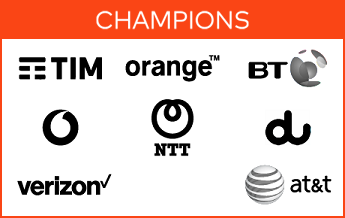
Connecting the dots between 5G, augmented reality & multi-access edge computing:
TM Forum award winning Blade Runner Catalyst
The 1982 science-fiction film Blade Runner and the 2017 sequel Blade Runner 2049, delve into the effects of technology on the environment and society in a bleak, dystopian future. The ambitious TM Forum catalyst “Blade Runner” proof-of-concept, projects a much brighter future where communications service providers (CSPs) can use 5G, augmented reality (AR) and multi-access edge computing (MEC) to deliver high bandwidth, low latency enterprise services, delivered end-to-end across diverse partners’ networks.

Future 5G networks will introduce a new era of ways to consume data and internet of things (IoT) use cases, especially around smart cities and smart industries. Many of these applications rely heavily on combined services provided by a diverse partner ecosystem, seamlessly working together to provision, monitor, monetize and assure them.
This introduces complexity both from a technology and a commercial aspect:
The Blade Runner catalyst clearly answers these questions by leveraging the right technology platforms coupled with the key principles of “standardization”. It demonstrates how service providers can model, expose, monitor, assure and monetize next generation 5G services between multiple operators, using TOSCA and Open APIs in order to create great enterprise customer experience, while also contributing towards technology standards such as ONAP and ODA.
A complex enterprise use case using AR to help local mining engineers repair earth-moving equipment (such as from Caterpillar or JCB) by receiving instructions from an expert located at an enterprise customer’s facility in another country.
The equipment engineer in the remote and hard-to-reach mine is fitted with Microsoft HoloLens hands-free AR googles, which he uses to connect with the expert via a Skype call. The expert can see exactly what the engineer in the mine sees and provide clear, step-by-step instructions for the repair. Both expert and engineer can draw and highlight on top of a 3D rendering of the truck.
Blade Runner makes use of industry standards, including Open APIs and modelling languages (TOSCA), to allow shared service catalogs and faster deployment of cloud services, and to provide end-to-end, multi-operator closed loop assurance and wholesale enterprise billing/charging operations.
The catalyst uses the TM Forum Open Digital Architecture (ODA) at its core to demonstrate the need for abstract orchestration layers, properly integrated through TM Forum Open APIs. It demonstrates how a modelling language can enable a shared definition of complex 5G service chains that can be deployed by different operators. In addition, standard models provide a set of common policies/rules to serve the needs of closed loop assurance, even across different enablers.
New emerging technology and network advancements (including 5G with network slicing, NFV, SDN and cloud-based platforms) present the opportunity for the CSP to transform into a digital service provider. By combining these services, the service provider can move beyond being just a connectivity provider to become an enabler in a complex ecosystem spanning many different verticals, especially across the IoT industry.
From a commercial perspective, a service provider can offer a set of new and different products that were not feasible before and extend the existing set of products and services with 3rd party services. The move towards cloud services means that a service provider can offer services faster and can configure them programmatically in near real time. Services can be instantiated and terminated dynamically on demand, as per the customer's needs, and the end user also has complete visibility depending on the service.
Subsequent Blade Runner phases will extend into end-to-end service orchestration for large enterprise customers with multiple global locations and even more complex service-monitoring scenarios. Because the service involves multiple service providers working in tandem, it is a priority to get security and data governance right. Further phases will explore business cases and benefits for real time policy management and charging for cloud services, including self-healing and spot pricing, a concept that has been introduced by AWS but so far hasn’t been applied in a telco environment.